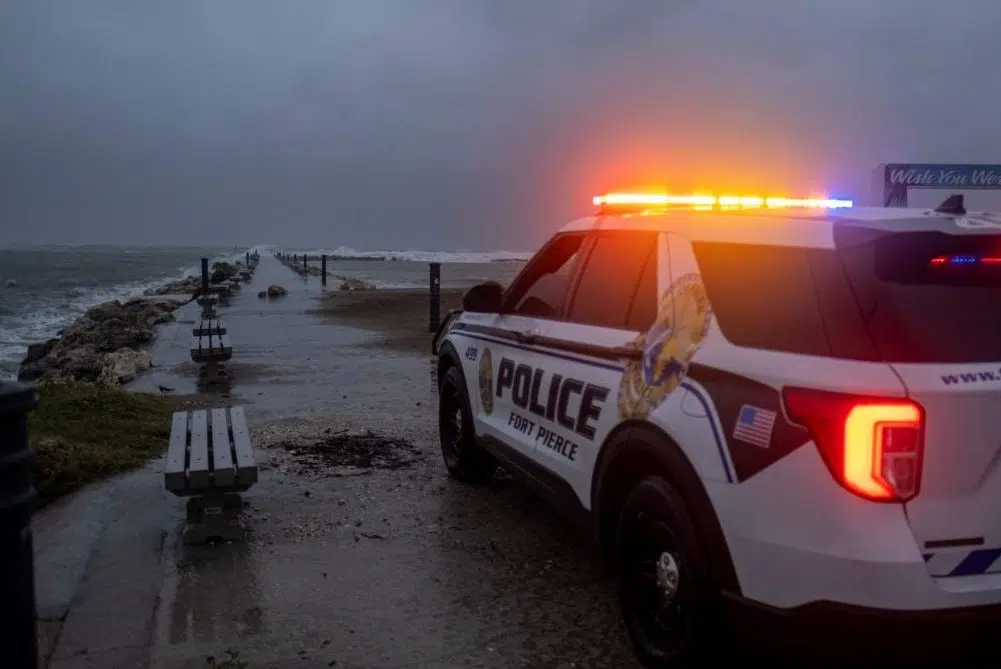MIAMI (Reuters) -Hurricane Nicole weakened into a tropical storm on Thursday shortly after making landfall on Florida’s east coast after barreling ashore with a brew of heavy downpours and fierce winds, the National Weather Service said.
Nicole had threatened coastal areas still reeling from the last major storm six weeks ago.
A hurricane warning had been posted for a 240-mile coastal stretch that included the Kennedy Space Center at Cape Canaveral, where NASA’s new moon rocket stood exposed to the elements and anchored to its launch pad to ride out the storm.
Nicole was downgraded from a Category 1 hurricane to a tropical storm as it moved inland from Florida’s coastline on Thursday.
The storm, which officially came ashore at 3 a.m EST, was packing sustained winds of up to 75 mph as it made landfall along the east coast of Florida north of Miami, the National Hurricane Center said. Speeds later dropped to 70 mph.
The hurricane center had issued storm-surge advisories for much of Florida’s Atlantic coast, warning that wind-driven waves would wash over beaches and rush inland to flood low-lying areas well beyond the shore.
Storm surges wreaked havoc along the state’s Gulf Coast and its eastern seaboard when Hurricane Ian crashed ashore on Sept. 28 and plowed across the Florida Peninsula to the Atlantic, causing an estimated $60 billion in damage and killing more than 140 people.
Nicole had been expected to pack less punch at landfall than Ian, which struck Florida as a major Category 4 storm. Authorities warned, however, that Nicole still posed a formidable threat, especially to structures and coastal foundations weakened by Ian.
“Dozens upon dozens” of oceanside buildings in Volusia County, including high-rise condominiums, have been declared structurally unsafe since Ian, with some now “in imminent danger of collapsing” from further shoreline erosion, Sheriff Mike Chitwood said.
‘LAST OPPORTUNITY’
Volusia was one of several coastal counties where officials issued mandatory evacuation orders or advised residents in oceanside communities and barrier islands to seek higher ground.
“This is the last window of opportunity to secure your families and to secure your properties and possibly save some lives,” Chitwood said in a video posted online on Wednesday.
State officials opened 15 emergency shelters across the region, activated 600 National Guard troops and placed 1,600 utility workers on standby to restore power knocked out by the storm.
More than a dozen school districts were closed on Wednesday and more than 20 school districts across the state were scheduled to be shuttered on Thursday. Orlando International Airport announced it was ceasing commercial operations on Wednesday afternoon.
Even before reaching hurricane strength, the storm unleashed “extensive flooding” across much of the Bahamas, including the islands of Grand Bahama, Eleuthera, Andros and the Abacos, National Emergency Management Agency chief Captain Stephen Russell told a news conference.
The storm was declared a hurricane on Wednesday evening as it made its first landfall on Grand Bahama island in the northwestern corner of the Atlantic West Indies archipelago nation.
Nicole was expected to diminish as it moves over Florida, then churns north over the next two days through Georgia and into the Carolinas.
(Reporting by Brian Ellsworth in Miami; Additional reporting by Jasper Ward in Nassau, Sandra Stojanovic in Daytona Beach, Fla. and Akriti Sharma in Bengaluru, Brendan O’Brien in Chicago and Rich McKay in Atlanta; Writing and additional reporting by Steve Gorman in Los Angeles; Editing by Mark Heinrich and Alison Williams)







Comments